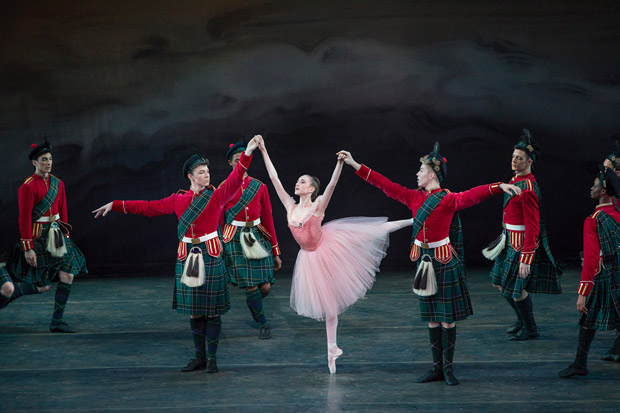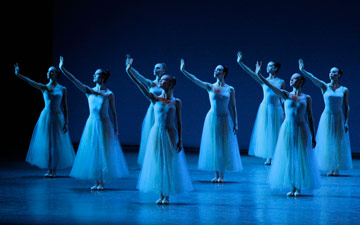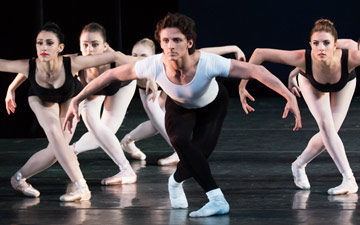
© Paul Kolnik. (Click image for larger version)
School of American Ballet
Workshop Performance: Scènes de Ballet, Hallelujah Junction, Scotch Symphony
★★★★✰
New York, Peter Jay Sharp Theatre
6 June 2017
sab.org
Top of their Class
New York City Ballet’s seemingly endless stream of new talent has a source, and that source is the School of American Ballet; this is why ballet-watchers flock to the school’s yearly Workshop Performances in late spring, binoculars in hand. It is here that future NYCB apprentices get their first taste of the spotlight, only to disappear into the ranks of the corps de ballet. If they’re lucky and strong and all goes well, they’ll eventually emerge from the crowd once again, back into the light.
But before that difficult process begins, these young dancers are presented to the world in these lovingly-prepared performances. After each ballet, the people who staged it – their teachers – receive flowers. They’re the essential, immutable members of this ballet family, the keepers of Balanchine’s steps and style. First among them, Suki Schorer and Susan Pilarre, who have been at SAB for 45 and 31 years respectively.

© Paul Kolnik. (Click image for larger version)
This sense of continuity, built into the soul of the artform, is the subject of Christopher Wheeldon’s Scènes de Ballet, which opened this year’s Workshop program. Wheeldon created it for SAB’s students in 1999 and set it in a ballet studio, as imagined by the illustrator Ian Falconer, a cross between the Bolshoi and the Paris Opera school. The airy room is traversed by a barre, the conceit being that the children of various ages can see their reflections in a giant mirror. The reflection is, of course, another dancer of the same size. The dances proceed from the simplest steps for the littlest dancers – impeccably rehearsed – to more complex combinations and partnering sequences for the older kids. The joy lies in the fact that the littlest ones are as polished, as courtly, as well-mannered and composed, as the eldest. The music, by Stravinsky, has always struck me as completely un-childlike, but at least it was well played by the so-called Workshop Orchestra, led by Daniel Capps, who also conducts at NYCB.

© Paul Kolnik. (Click image for larger version)
Peter Martins’ Hallelujah Junction, which followed, also makes a good primer for students. Its driving score for two pianos by John Adams sets a relentless pace, which the young dancers have to match – a good preparation for life at NYCB. (The pianists were Susan Walters and Cameron Grant.) The ballet also contains many small cameos, so that all of the dancers have their moment. The look is sharp and frontal, bodies extended and electric, phrases punctuated by sharp kicks and flicks. Positions are either open or sharply crossed; the footwork is syncopated and fleet. The young dancers acquitted themselves well, particularly Roman Mejía in a killer solo that includes a hair-raising combination of fast-moving turns, jumps, and backward-flying steps. India Bradley and Nathan Compiano were stylishly mature in a jazzy pas de deux full of sharp changes of direction and whipping arm movements.
But the piece everyone was waiting for was George Balanchine’s 1952 Scotch Symphony, all-too-infrequently performed at New York City Ballet. Balanchine composed the ballet, which is set to the last three movements of Mendelssohn’s Scottish Symphony, after taking the company to Scotland. He was impressed with the Scottish dances and parades he saw there, and this was the result, along with the opening section of Union Jack – but that came later. The ballet incorporates elements of Scottish dancing, particularly in the first section, with its fast, buoyant footwork and upheld arms. Then it morphs into a kind of précis of themes lifted from the Romantic ballet La Sylphide. (Also set in Scotland, I might add.)

© Paul Kolnik. (Click image for larger version)
In the zippy opening, a woman wearing a kilt – normally men’s attire – engages in a solo, and then a trio with two men, full of saucy walks on demi-pointe accompanied by sashays of the shoulders, and devilish footwork, much of it drawn from the male canon. At one point she does two diagonals of fast brisé jumps, reminiscent of Albrecht’s febrile diagonal in the second act of Giselle. Then comes the sylvan, haunted pas de deux, in which a sylph-like woman lures, but also eludes, a yearning young man. She is tossed into his arms by two men who act as her guards, who just as quickly pull her away. The young man reaches for her, but the guards block the way imperiously. There’s a whiff of the Vision Scene from Sleeping Beauty here, but the mood is rendered more formal by the fact that the figures blocking the way are men. Each time, she returns and the two dance some more; the partnering is light-handed, soft, airy, leaving the maximum amount of space between their two bodies. It’s a lovely and strange ballet, a kind of patchwork of themes held together by the music. Gabriella Domini, as the sylph, was light, elegant, elusive, and assured. The boyish Andres Zuniga more than held his own in the quick, light-footed petit allegro steps.
It’s impossible to know what the future holds in store for these young dancers, but it is always a joy to see them at this point, so full of potential, ready and eager to take the next step.
After the show, eight new apprentices were named: Gabriella Domini, Nieve Corrigan, Mary Thomas MacKinnon, India Bradley, Andres Zuniga, Gilbert Bolden, Darius Black and Roman Mejia. Congratulations to all.

















The solo girl in “Scotch Symphony” you spoke of was Kristina Hadjipetkov